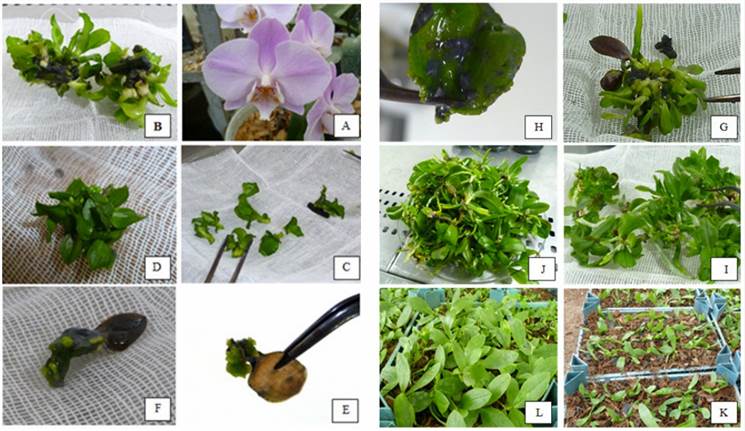Phalaenopsis amabilis is a tropical epiphytic orchid belonging to the genus Phalaenopsis of the family Orchidaceae, known as the "Queen of Orchids". Its flowers are as big as butterflies, beautiful in shape, bright in color, rich in color and luster, and have a long-lasting flowering period. It has become one of the rare and high-end flowers. Because Phalaenopsis is a single-stem aerial orchid, it is difficult to propagate by division. Under normal circumstances, the seeds are not fully developed and are extremely difficult to germinate, so tissue culture is often used to propagate seedlings.
Principle
In recent years, most researches on tissue culture of Phalaenopsis use embryos, young leaves, stem tips, root tips, pedicel axillary buds and other organs as explants for tissue culture research. Because the pedicel axillary buds of Phalaenopsis have the characteristics of easy material collection and disinfection, no damage to the mother plant, good tissue culture effect and easy tissue culture success, so the pedicel with axillary buds is used as explants in this scheme. There are two main ways for Phalaenopsis to undergo rapid propagation through pedicel axillary buds. The first is the cluster bud approach, the pedicel axillary buds directly form cluster buds by inducing multiplication, and then form seedlings. The second is the protocorm approach. The pedicel axillary buds are induced to form cluster buds, and then the cluster buds are induced to form protocorms, and finally a complete plant is formed through subculture and rooting.
 Figure 1. The main stages of producing plantlets from leaves that had grown in vitro from the initial tissue culture of nodes of flower stalks. (Balilashaki, K.; et al. 2016)
Figure 1. The main stages of producing plantlets from leaves that had grown in vitro from the initial tissue culture of nodes of flower stalks. (Balilashaki, K.; et al. 2016)
Procedures
- Selection and Disinfection of Explants
Cut off the pedicels from the mother plant, cut off its bud stem segment, which is about 3 cm long, and clean it with tap water. Soak in the supernatant of saturated bleaching powder for 15 minutes, stirring constantly while soaking. After soaking, the stem segments were rinsed with running water, placed on an ultra-clean workbench, disinfected with 75% alcohol for 30 s, and washed once with sterile water. Then soak in 0.1% mercuric chloride for 10 min (continuously stir with glass rod during the soaking process), rinse with sterile water for 5 times, and put it on a sterile clean petri dish for later use.
- Inoculation
Under sterile conditions, use a sterile knife to cut the stems into about 2 cm sections with full axillary buds. The buds were inoculated on the induction medium with the buds facing upward, the culture temperature was (25 ± 1) °C, the light intensity was 1500 lx, and the light time was 12 h per day.
- Proliferation of Cluster Buds
When the pedicel axillary buds were cultured for 55-60 days, the part where the base of the pedicel was in contact with the medium gradually turned black. At this time, the induced clustered buds were divided into single buds and double buds and transferred to the clustered bud proliferation medium for subculture, and new clustered buds could be generated after about 50 days.
- Rooting and Transplanting
The obtained proliferating shoots were transferred to the rooting medium for rooting and strong seedlings, and the roots took about 20 days. Phalaenopsis test-tube seedlings can be domesticated and transplanted when they have 3-4 roots, 3-4 leaves and 3-5 cm long leaves. Move the test-tube seedlings to a bright and ventilated seedling hardening room, uncover the bottle cap and harden the seedlings for 2-3 days, then take out the seedlings, and wash the culture medium sticking to the roots. Soak the test-tube seedlings in 0.1% potassium permanganate solution for 20-30 min, and then transplant them to the sterilized moss substrate. The newly transplanted Phalaenopsis should be in a light intensity of 1500-2500 lx, a temperature of 25-30°C, an air humidity of 85%, and a well-ventilated environment to facilitate the rapid growth of test-tube seedlings.
Note:
- According to the different collection time and different Phalaenopsis species, we should explore the appropriate sterilization time during the pre-experiment. If the growth environment of Phalaenopsis is relatively dirty, the sterilization time can be increased appropriately, but at this time the explants may suffer greater damage.
- After the test-tube seedlings are hardened and transplanted, 100% air humidity and proper sunshade should be maintained within 1 week, which can greatly improve the survival rate of the test-tube seedlings.
Reference
- Balilashaki, K., Ghehsareh, M.G. Micropropagation of Phalaenopsis amabilis var. 'Manila' by leaves obtained from in vitro culturing the nodes of flower stalks. Notulae Scientia Biologicae, 2016, 8(2): 164–169.
Our products/services are For Research Use Only. Not For Clinical Use!
 MEET US AT PLANT BIOLOGY 2024 June 22-26, 2024 Honolulu, Hl #309Learn More
MEET US AT PLANT BIOLOGY 2024 June 22-26, 2024 Honolulu, Hl #309Learn More
 Figure 1. The main stages of producing plantlets from leaves that had grown in vitro from the initial tissue culture of nodes of flower stalks. (Balilashaki, K.; et al. 2016)
Figure 1. The main stages of producing plantlets from leaves that had grown in vitro from the initial tissue culture of nodes of flower stalks. (Balilashaki, K.; et al. 2016)